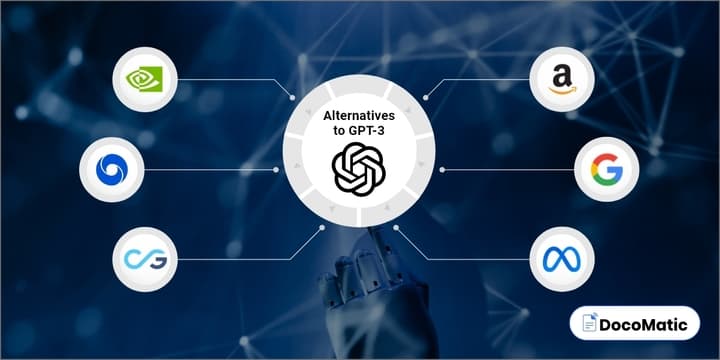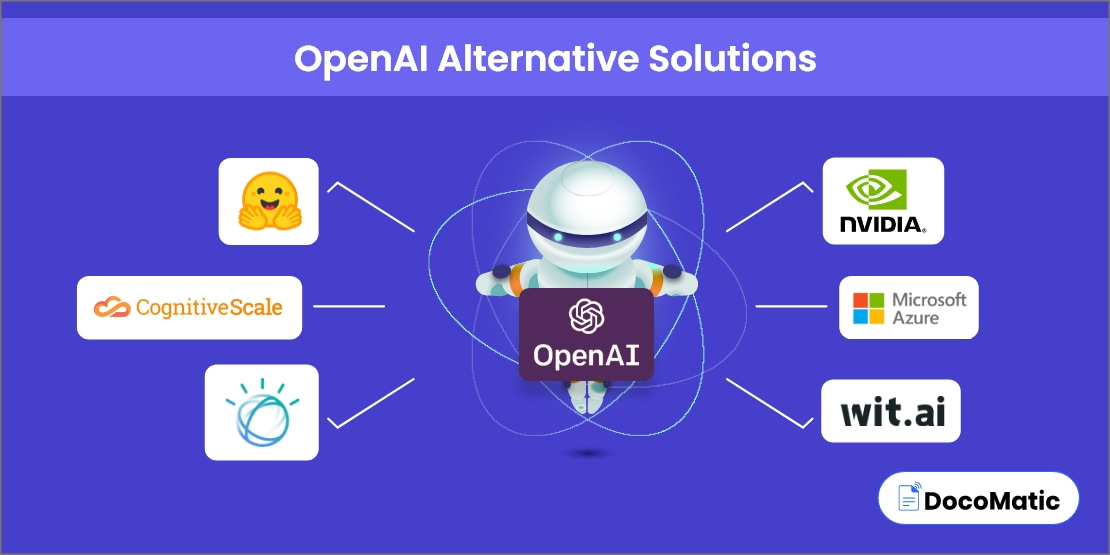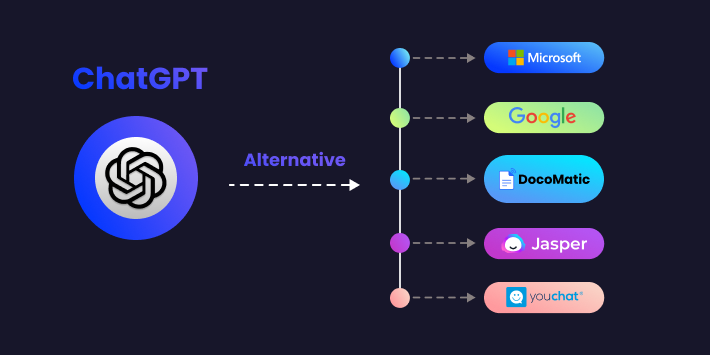Much like other OpenAI softwares, GPT-3 seems to be the go-to language model for companies that are looking for NLP solutions, though there are still some AI applications where it might not make the most sense.
Such applications are what give rise to a GPT-3 alternative to grow and flourish. It is not unusual to see companies being dissatisfied with the language model developed by OpenAI’s GPT-3. This is because GPT-3 is mainly made to cater to general queries humans ask, making it unsuitable for specialized applications and queries.
There is no doubt that the new AI projects saw some serious traction in 2022, though with all of these projects in the market, it can be confusing to choose the best GPT-3 alternative. This is why reading a blog that shows you all the alternatives in the market can be helpful.
Table of Content
10 Best Alternatives to GPT-3
This list of alternative AI models features a diverse yet reliable range of options to suit the needs of almost all users. Let us now look at all of these models and see how they can help your specific use case and industry in the best manner possible.
1. LaMDA by Google
Often referred to as the Arch Nemesis of OpenAI, Google has its own powerful language model named LaMDA. It was primarily launched to compete against GPT-3 and has made its rounds on the internet for that very reason. It is said to be the language model that powers Bard AI and offers more or less the same natural language understanding abilities.
LaMDA is mainly renowned for its advanced natural language processing and zero-shot learning abilities. It was made with somewhere around 137 billion parameters which is lower than that of GPT-3 at 175 billion. Though it does work with the latest data instead of being limited to older datasets.
2. GPT-J
Despite only having around 6 billion parameters to work with, the GPT-J text generator is able to outperform GPT-3 Babbage in certain regards. This artificial intelligence text generator made by EleutherIA is completely free to use by any developer.
Though it does get surpassed when you compare it to other versions of the GPT-3 NLP models, such as Curie or DaVinci. This is subject to change if you get to use GPT-NeoX, which works with over 20 billion samples, dwarfing previous models in comparison.
3. Megatron-Turing NLG
Two of the largest tech giants on the planet, Nvidia and Microsoft, collaborated to create Megatron-Turing NLG (Natural Language Generation). There is no doubt in the fact that the artificial intelligence models made by such massive tech titans are going to be working with massive parameters.
This holds true for the Megatron-Turning NLG, as it has more than 530 billion parameters to work with. Using these parameters, it can easily generate human-like text and perform very well on zero-shot learning tests. Its training data mostly comes from the Pile.
4. Chinchilla by DeepMind
How is an AI model with only 70 billion parameters able to outperform large-scale language models? Well, Chinchilla, developed by DeepMind, has the answer, and that is by using 1.4 trillion tokens to train the AI to deliver more accurate results.
Seeing how Chinchilla is able to offer an accuracy of over 67% after 5 shots compared to GPT, with only over 43%, is honestly shocking. This method of using training tokens instead of additional parameters shows how other AI programs could potentially improve performance.
5. OPT by Meta
OPT, which stands for Open Pretrained Transformer, is a large language model that was developed by the tech giant Meta and was launched in the middle of 2022. Its ability to use both pre-trained models and source code for learning is what separates it from the competition.
As of now, non-commercial licenses are selectively only given out to a few organizations for the sole purpose of conducting research. Meta has done this to learn the ethical use cases and utilities presented to the market with large language models.
6. BLOOM
With the help of over a thousand AI researchers from massive tech firms, BLOOM was developed to be an open-source alternative to GPT-3. If you agree to their licensing terms, then you can use them for free to experiment and learn more about large language models.
It works on over 176 billion parameters which are similar to that of GPT-3 at 175 billion. Though one of its biggest caveats is reduced performance due to it being based on the Megatron-LM language processor, it follows a decoder-only architecture like GPT-3. It also has smaller versions of this model for additional testing.
7. GLaM
GLaM, or Generalist Language Model, is noteworthy in its functioning due to its unique method of filtering results. This language model developed by Google uses a massive 1.2 trillion parameters, which are nearly 7 times that of GPT-3, making it one of the biggest in this industry.
It uses the Mixture of Experts (MoE) model to filter the results for any given prompt to make it as accurate and relevant to the query as possible. As you can imagine, such massive parameters make it easy for GLam to surpass GPT-3 in one-shot and zero-shot learning tests.
Though, unlike the other models on this list, GlaM has not given out full access to its source code to the public. This means that it is not an open-source alternative to GPT-3, unlike most of the other models on this list.
8. CodeGen
The sole purpose of developing CodeGen was to focus more on the ability of AI to code. Thus it has been fine-tuned to create code out of simple human text prompts. Its parameters vary from 350 million all the way up to 16 billion using a variety of datasets, including the Pile and Corpus.
Developed by SalesForce, the AI’s primary objective is to string together code to give programming abilities to even those that are not very savvy about the field. If your objective is to turn text data into functioning code, then CodeGen would be the ideal solution.
9. BERT by Google
The Bidirectional Encoder Representations from Transformers or BERT developed by Google is one of the oldest GPT-3 alternatives on this list, as it was open-sourced all the way back in 2018. Despite its age, it allows for greater customization, making it superior to GPT-3 in some regards.
It was used to understand the intentions of users for search queries and is also able to generate text by contextualizing it with previous queries. This combined with the fact that it is an open-source alternative is what makes BERT the ideal choice for question-answer systems.
10. AlexaTM
AlexaTM was developed and released by Amazon in late 2022. Its biggest and most handy ability is that it is a multilingual language model that supports languages such as English, Japanese, Hindi, Arabic, Spanish, and more.
It uses an Encoder-decoder model, which allows it to outperform the PaLM 540B with only 20 billion parameters on tasks such as machine translation and one-shot learning. Such unique abilities are what separates it from other language models on the market.
Why do Companies Want Alternatives to GPT-3?
While any form of competition is healthy for all markets and consumers, what is GPT-3 doing that leaves developers wanting general or open-source alternatives for a language model. To gain some perspective, let us look at the common reasons for wanting alternatives to GPT-3.
1. Lower costs
The cost of using something like GPT-3 for your NLP tasks can turn out to be quite a heavy load on your wallet. This is why companies often look for more affordable alternatives to balance costs while not losing out on the amazing features of an AI chatbot.
This is especially true for small-scale research applications where funds are usually limited and sparse. Thankfully, free, open-source models facilitate the ability to experiment with NLP without having to incur massive upfront costs.
2. Greater customization ability
The ability to personalize any pretrained models to suit your requirements is a trait pursued by developers all over the globe. So naturally, any language processor that allows more room for custom calibration is going to be more sought after for targeted application cases.
This is why open-source artificial intelligence models are in high demand. This is to allow for getting the best experience for your particular needs. Though you can still learn how to train GPT-3 to meet your requirements as long as OpenAI GPT-3 gets more open-source.
Create a GPT-3 Powered Chatbot Using Custom Data With DocoMatic
Most companies across the globe are always looking to improve and automate the way they deal with simple queries from both internal and external sources. Usually, this is done with an online database but they are very limited in providing answers to questions that are written in a different manner than what is given in the database.
This is why DocoMatic is here to deliver the perfect GPT-3 powered solution to resolving queries in a quick and concise manner. You need not be an AI professional to configure your own Chatbot with advanced NLP abilities when you have DocoMatic by your side.
The creation of such a database is as simple as copying and pasting the sources of information and allowing the software to sync to it. The process of creating a custom Chatbot for your business has never been easier all thanks to the amazing abilities granted by DocoMatic.
FAQs
Yes, advanced natural language processors such as BLOOM have remained free for both individuals and research organizations. This is because it was built to be one of the few GPT-3 open-source alternatives to promote research and the development of technology without having to burden the costs behind it.
Wu Dao is a Chinese language model that has 1.75 trillion parameters which are 10 times bigger than that of OpenAI’s GPT-3 model. Though it is uncertain if Wu Dao will hold this record for long as the AI model GPT-4 claims to have over 170 trillion parameters to work with.
While its applications to generate images are limited, it can be used to interpret the data presented by images with adequate training. This can be used in the medical sector to analyze reports and scans to give you a more accurate diagnosis.
Conclusion
When you know about OpenAI, the company behind ChatGPT, you will see why the Generative Pre-trained Transformer 3 language model is suitable for most applications, it does have some areas that leave more to be desired. The saving grace for such cases is an alternative language process that can fulfill the gaps that are created by GPT-3 for the companies that need it.
There are many diverse alternatives on the market that serve different purposes to suit your needs in the most optimal manner. Some are built to outperform GPT-3 on some applications, while others are built to be more affordable and experimental for smaller companies.
This is why it is best to scope out the market and look around for an alternative AI model to any standard solution, as it may give you the best language model for your business applications. Pitting AI models head to head is how the entire industry moves ahead as a collective.


